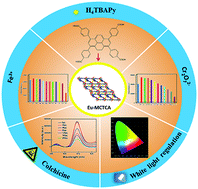A lanthanide–organic crystalline framework material encapsulating 1,3,6,8-tetrakis(p-benzoic acid)pyrene: selective sensing of Fe3+, Cr2O72− and colchicine and white-light emission†
Abstract
A facile strategy was used to construct a series of composite materials with color-tunable and white light emission by encapsulating 1,3,6,8-tetrakis(p-benzoic acid)pyrene (H4TBAPy) into framework material [Eu(MCTCA)1.5(H2O)2]·1.75H2O (Eu-MCTCA), which is synthesized based on Eu(NO3)3·6H2O and 5-methyl-1-(4-carboxylphenyl)-1H-1,2,3-triazole-4-carboxylic acid (H2MCTCA). A slight adjustment of the emission color can be easily fulfilled by simply altering the concentration of H4TBAPy or regulating the excitation wavelength. Notably, white light emitting Eu-MCTCA@H4TBAPy can be realized by encapsulating H4TBAPy with a concentration of 0.75 mM, when the excitation wavelength is 350 nm. Furthermore, based on the favorable luminescence and stable structure of Eu-MCTCA@H4TBAPy in water or organic solvents, Eu-MCTCA@H4TBAPy can be used as a potential luminescent probe for detecting Fe3+, Cr2O72− and colchicine.



 Please wait while we load your content...
Please wait while we load your content...